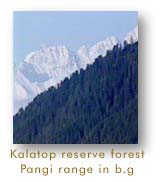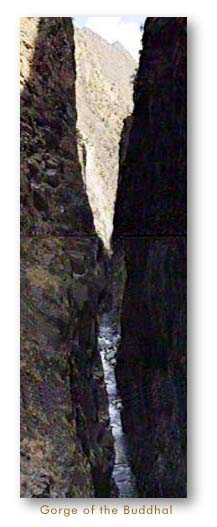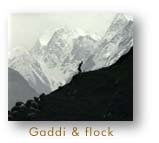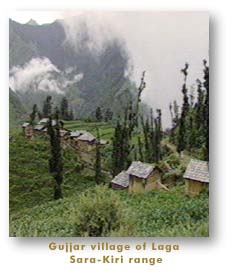 |
 |
 Chamba valley lies enclosed between two principal spur ranges of the Great Himalaya, the Dhauladhar and the Pangi-Pir Panjal.
The sedimentary deposits of the Shivaliks give way to the first granite range in the system, the Dhauladhar. The Pir Panjal runs
roughly parallel, to the north but on a converging line, and in between lies the drainage basin of the Ravi, one of the principal
rivers of the Punjab. The Ravi arises in two streams, the Kalihain from the glaciers in the Bara-Banghal basin, and the Buddhal from the
snowfields of Kugti and Manimahesh. Dividing the two is the outthrust spur of the small Manimahesh range, named after the
mountain revered locally as an abode of Lord Shiva. The Buddhal , so named because it resembles an old man's flowing white
beard, has after Brahmour, carved out one of the most stupendous gorges anywhere in the Himalaya, which, in it's last portion, degenerates
to a fearsome overhang carved out of granite.
Chamba valley lies enclosed between two principal spur ranges of the Great Himalaya, the Dhauladhar and the Pangi-Pir Panjal.
The sedimentary deposits of the Shivaliks give way to the first granite range in the system, the Dhauladhar. The Pir Panjal runs
roughly parallel, to the north but on a converging line, and in between lies the drainage basin of the Ravi, one of the principal
rivers of the Punjab. The Ravi arises in two streams, the Kalihain from the glaciers in the Bara-Banghal basin, and the Buddhal from the
snowfields of Kugti and Manimahesh. Dividing the two is the outthrust spur of the small Manimahesh range, named after the
mountain revered locally as an abode of Lord Shiva. The Buddhal , so named because it resembles an old man's flowing white
beard, has after Brahmour, carved out one of the most stupendous gorges anywhere in the Himalaya, which, in it's last portion, degenerates
to a fearsome overhang carved out of granite.
 The Ravi, one of the lesser known of the Himalayan rivers, has also, carved out for itself, one of the
sheerest gorges in the entire Himalaya. Upstream from the medieval town of Chamba, the gorge
narrows, into an actual overhang near Brahmour, only widening up at over 7,000 feet.
The Ravi, one of the lesser known of the Himalayan rivers, has also, carved out for itself, one of the
sheerest gorges in the entire Himalaya. Upstream from the medieval town of Chamba, the gorge
narrows, into an actual overhang near Brahmour, only widening up at over 7,000 feet.
Tucked away behind this impenetrable gorge, Brahmour, the ancient capital of the Chamba kings, flourished
for centuries, looking towards and trading with, the transhimalayan kingdoms through the vital Kugti pass. In
Brahmour we find the world famous complex of the Chaurasi, or, eighty four temples, built between the 6th
and 12th centuries A.D. This complex is home to one of the oldest surviving wooden temples in the world,the
temple of Lakhna Devi, it's exquisite carvings attributed to the master sculptor - Gugga, the Michealangelo
of the Himalaya.
 Brahmour is also the home of the Gaddi shepherds, migratory herdsmen who take their flocks over the high
passes to the high altitude grasslands of Lahaul and the Miyar Nala.
The Gaddis are great travellers, armed with the company of their ferocious sheep dogs with their spiked iron collars, enough
to give even the most belligerent leopard a second thought, the Gaddis travel through some of the wildest and most beautiful alpine landscapes
on earth. Using three main passes, the Kugti, Kalicho and Chobia, sixteen thousanders all, they fan out in Lahoul, and as the
snows recede and the fresh grasses emerge, the Gaddis climb towards the higher pasturelands at 15 -16,000 feet. It is a
dangerous life - there are hazardous pass and river crossings, and no recourse to medical aid in case of an accident, no
emergency services or rescue helicopters. Even high pass crossings can be more hazardous than is generally supposed.
Late western cyclonic disturbances can affect the Punjab Himalaya as late as May. Often a few hours may hold the balance
between a safe crossing ar tragedy from avalanche or blizzard. Approaching a pass, protective incantations in the name of
Lord Shiva are whispered.
Brahmour is also the home of the Gaddi shepherds, migratory herdsmen who take their flocks over the high
passes to the high altitude grasslands of Lahaul and the Miyar Nala.
The Gaddis are great travellers, armed with the company of their ferocious sheep dogs with their spiked iron collars, enough
to give even the most belligerent leopard a second thought, the Gaddis travel through some of the wildest and most beautiful alpine landscapes
on earth. Using three main passes, the Kugti, Kalicho and Chobia, sixteen thousanders all, they fan out in Lahoul, and as the
snows recede and the fresh grasses emerge, the Gaddis climb towards the higher pasturelands at 15 -16,000 feet. It is a
dangerous life - there are hazardous pass and river crossings, and no recourse to medical aid in case of an accident, no
emergency services or rescue helicopters. Even high pass crossings can be more hazardous than is generally supposed.
Late western cyclonic disturbances can affect the Punjab Himalaya as late as May. Often a few hours may hold the balance
between a safe crossing ar tragedy from avalanche or blizzard. Approaching a pass, protective incantations in the name of
Lord Shiva are whispered.
 From Brahmour leads the centuries old pilgrim trail to Manimahesh, the abode of Lord Shiva. A short, but steep, 13 km climb along
a source stream of the Buddhal, brings us to a morainic lake at 13,500 feet. The frost rimmed waters of the lake reflect the main massif
of Manimahesh, standing alone with no other peak nearby to dim it's glory. Manimahesh stands at the head of it's own little
range, an outthrust spur which joins up with the main range near the Bara Banghal pass.
From Brahmour leads the centuries old pilgrim trail to Manimahesh, the abode of Lord Shiva. A short, but steep, 13 km climb along
a source stream of the Buddhal, brings us to a morainic lake at 13,500 feet. The frost rimmed waters of the lake reflect the main massif
of Manimahesh, standing alone with no other peak nearby to dim it's glory. Manimahesh stands at the head of it's own little
range, an outthrust spur which joins up with the main range near the Bara Banghal pass.
Brahmour is Shivbhoomi, Shiva's heartland, and the Gaddis consider Lord Shiva their gaurdian shepherd. Manimahesh is a
regular pilgrimage and amongst the Gaddis legends abound, of encounters with Shiva and the violence of his displeasure,
as manifested through avalanches and the like.
After the 10th century, the capital of the Chamba kings shifted to Chamba, which occupies a central position in the valley. At the point where the gorge of the Ravi widens into a gentler valley, stands the medieval town of Chamba. Built atop a plateau overlooking the
river, access to the town is across a single suspension bridge. At the heart of the town is the chaugan, the Raja's polo grounds,
overlooked by the palace itself. The chaugan is also the center of Chamba's social life. People collect here in the evenings to
chat, promenade, play cards or just generally picnic. The famous minjar mela takes place here and it also serves as the
encampment of all manners of nomadic peoples and their animals.
At the point where the gorge of the Ravi widens into a gentler valley, stands the medieval town of Chamba. Built atop a plateau overlooking the
river, access to the town is across a single suspension bridge. At the heart of the town is the chaugan, the Raja's polo grounds,
overlooked by the palace itself. The chaugan is also the center of Chamba's social life. People collect here in the evenings to
chat, promenade, play cards or just generally picnic. The famous minjar mela takes place here and it also serves as the
encampment of all manners of nomadic peoples and their animals.
Chamba has often been referred to as the Florence of the Himalaya, for like that Italian city, it abounds in street and curbside
art treasures as well as a host of magnificient temples and idols. The rulers of Chamba in the 10th and 11th century were
great temple builders and patrons of the arts, which consequently flourished. A uniquely chambiad art form was the
rumal, or handkerchief with fine embroidery. Examples of the Chamba rumal can be seen at the local Bhuri Singh Museum.
During this golden age was built the famous Laxminarayan group of temples.
Above Chamba is one of the world's great reserve forests - the Sara-Kiri reserve, home to the nomadic Gujjars. The Gujjars
are nomadic muslim milch cattle herders who, like the Gaddis follow their cattle to the high pastures in the summer. The difference
 is that they along with their buffaloes go upto around 12,000 feet only and they travel as entire family groupings. Gujjar
encampements, low log structures, can be found all over the region, especially near Laga and other areas above 8,000 feet.
Gujjars make heroic daily journeys to dispose of the milk in the lower towns , with 8,000 feet of fully laden descent and ascent
a daily feature.
is that they along with their buffaloes go upto around 12,000 feet only and they travel as entire family groupings. Gujjar
encampements, low log structures, can be found all over the region, especially near Laga and other areas above 8,000 feet.
Gujjars make heroic daily journeys to dispose of the milk in the lower towns , with 8,000 feet of fully laden descent and ascent
a daily feature.
Downstream from Chamba the Biara-Siul stream meets up with the Ravi. The Baira Siul emnates from the extensive snowfields
on the Sach pass, the traditional route into Pangi, one of the most remote and difficult to access areas in the entire country.
One can either trek across the 14,000 foot Sach pass or go in by Helicopter, a service run by the government for it's employees
and local residents. Pangi lies in the Chenab-Chandrabhaga valley and motorable access from Udaipur in Lahaul is under development.
The trek across the Sach pass starts from Satrundhi with Tissa the nearest town of any size.
 The gateway to the Chamba valley is Dalhousie. This colonial hill town was founded in the 1850's by Lord Dalhousie, the
then Viceroy of the British crown. Originally intended as a sanatorium and R&R centre for the British tommies escaping the
summer heat of the plains. The town itself was settled by the burra-sahibs who built in the fashion of the Scottish and northern
English countryside. And so, the lodges and houses built by them still have names like Penshurst, Balmoral, Belmont etc. Besides
the fascinating colonial architecture, Dalhousie boasts of some very nice walks and some exhilarating views of the entire Pangi
range.
The gateway to the Chamba valley is Dalhousie. This colonial hill town was founded in the 1850's by Lord Dalhousie, the
then Viceroy of the British crown. Originally intended as a sanatorium and R&R centre for the British tommies escaping the
summer heat of the plains. The town itself was settled by the burra-sahibs who built in the fashion of the Scottish and northern
English countryside. And so, the lodges and houses built by them still have names like Penshurst, Balmoral, Belmont etc. Besides
the fascinating colonial architecture, Dalhousie boasts of some very nice walks and some exhilarating views of the entire Pangi
range.
Khajjiar, near Dalhousie, is one of the area's principal tourist attractions. Emerald meadows surrounded by thick Deodar(cedar) forest, Khajjiar can have a magical air. In one fold of the meadow is the tiny village with an ancient temple of Nag devta. At the center
of the sloping meadows is a small bog like lake that serves as the drainage basin for the surrounding meadows and forest. Khajjiar was probably
a glacial bowl formed during the last Himalayan ice age and left with a morainic lake that gradually withered away. Today the green
meadows are also in danger of withering away due to severe human pressure. Misleading advertising of the bog as a lake by overzealous
tourism authorities have created a visitor overload for this tiny place. Besides the tourists, Khajjiar is a highly popular place
for youth camps of all sorts. To compound the mess, Bombay filmmakers have also 'discovered' Khajjiar as a place for
picturising songs. Khajjiar unfortunately does not have the dimesions of Gulmarg in Kashmir being a very small place. Even
though a part of the notified Kalatop-Khajjiar sanctuary, it is nowadays a challenging job to spot the Monal pheasant, a bird
common in the area till fairly recently.
Khajjiar can have a magical air. In one fold of the meadow is the tiny village with an ancient temple of Nag devta. At the center
of the sloping meadows is a small bog like lake that serves as the drainage basin for the surrounding meadows and forest. Khajjiar was probably
a glacial bowl formed during the last Himalayan ice age and left with a morainic lake that gradually withered away. Today the green
meadows are also in danger of withering away due to severe human pressure. Misleading advertising of the bog as a lake by overzealous
tourism authorities have created a visitor overload for this tiny place. Besides the tourists, Khajjiar is a highly popular place
for youth camps of all sorts. To compound the mess, Bombay filmmakers have also 'discovered' Khajjiar as a place for
picturising songs. Khajjiar unfortunately does not have the dimesions of Gulmarg in Kashmir being a very small place. Even
though a part of the notified Kalatop-Khajjiar sanctuary, it is nowadays a challenging job to spot the Monal pheasant, a bird
common in the area till fairly recently.
|
|